The National Nuclear Security Administration (NNSA) has one unwavering counterterrorism / counterproliferation mission: to protect the public from radiological hazards, both anticipated and unforeseen. The Nuclear Emergency Support Team (NEST) is NNSA’s multi-mission nuclear emergency response capability that leverages the Department of Energy’s (DOE) world-class scientists and technical experts to contend with the Nation’s most pressing radiological and nuclear challenges. NEST is the umbrella designation that encompasses all DOE/NNSA radiological and nuclear emergency response functions, some of which date back more than 60 years. NEST’s motto – “Scientifically Informed, Operationally Focused” – reflects the technical underpinning of its diverse operational missions.
A leader in this mission space, NEST’s Aerial Measuring System (AMS) program stands as the gold standard in airborne radiological monitoring. The expert pilots and scientists of the AMS are uniquely prepared to respond to any nuclear emergency in the United States within hours, ensuring both preemptive and reactive coverage with an impressive blend of speed, detail, and precision.
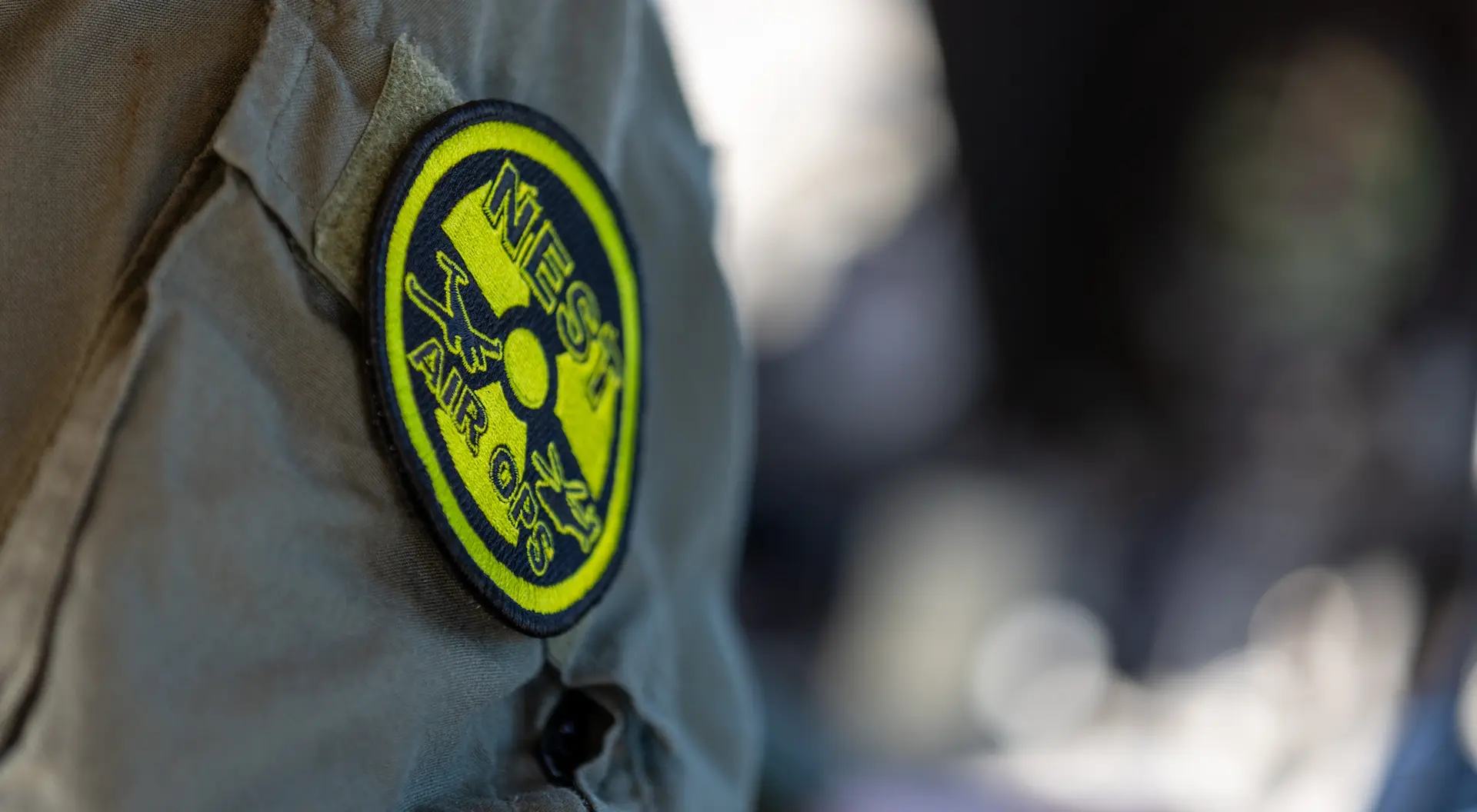
After nearly a decade of fleet modernization, AMS now operates NNSA owned aircraft from two strategic bases—one near Washington, D.C., and another in Las Vegas. With three Extended Range King Air 350s and two state-of-the-art AW139 helicopters, AMS teams are equipped with sophisticated monitoring systems that enhance public safety efforts in dealing with diverse radiological scenarios. A third AMS location in South Carolina flies NEST equipment on non-AMS owned aircraft in partnership with DOE and another federal agency. Recently, HeliOps visited AMS's dedicated crews at Joint Base Andrews to see firsthand how their new AW139s are taking this vital national security program to new heights.
Rooted in History
While the AMS program traces its roots back to airborne measurement efforts during atomic and nuclear weapons testing during the 1950s, it wasn’t until the very end of the 1990s that the AMS was officially created. Shortly after its formation by Congress in 2000, the AMS found itself responding to its first emergency in the early hours following the infamous 9/11 attacks when they were called upon to conduct radiological surveys over Ground Zero in New York City; a mission unlike any other. With the airspace tightly restricted and an atmosphere of intense security, the Bell 412 crew faced the task of surveying the remnants of the World Trade Center, searching for potential radiological material amidst the devastation.
After careful coordination with the Federal Aviation Administration (FAA) and law enforcement agencies to ensure the helicopter’s safe passage, Tim Rourke who has been with the unit for many years, was the mission pilot on 9/11. He and his crew finally received clearance to thread their way through the restricted airspace from Joint Base Andrews to New York City. Navigating a complex route through tightly secured airspace, they eventually arrived to conduct radiological surveys over the rubble-strewn site where the Twin Towers once stood.
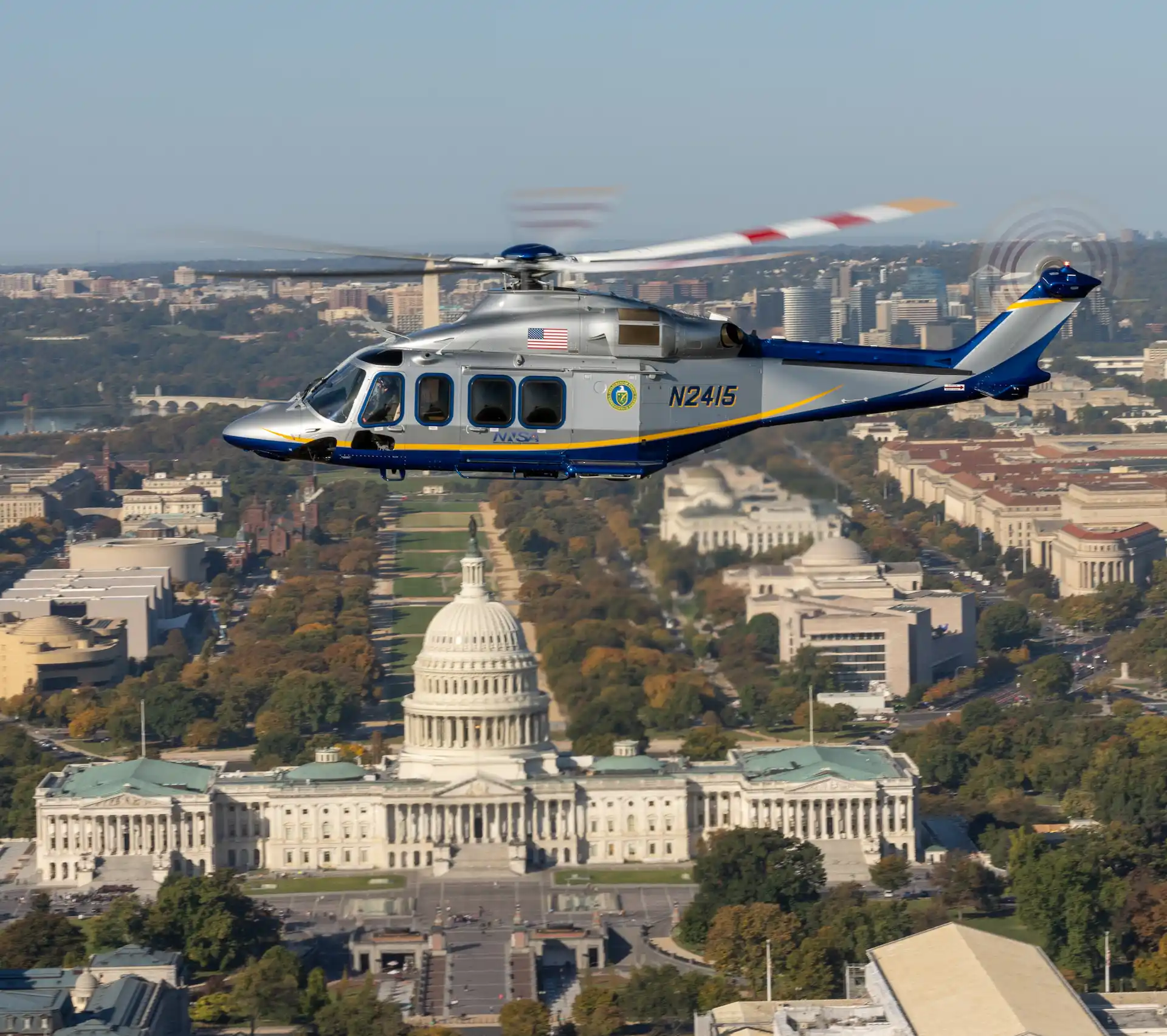
“It was surreal,” Tim Rourke recalled. “Flying over Ground Zero, we could still see smoke rising from the wreckage, and the sheer scale of the destruction was overwhelming. We were threading our way between buildings and trying to maintain precise flight lines in an environment that was anything but normal.”
Rourke noted how, even a week later, smoke was still rising from the smoldering ruins, giving the air a distinct, acrid smell. Beyond Ground Zero, his team also conducted surveys over the Staten Island landfill known as Fresh Kills, where debris was already being transported for sorting and investigation. Their work, later shifted in focus to using nitrogen-cooled, multi-spectral cameras requiring meticulous timing at twilight, which provided critical data to firefighting and recovery teams, by helping to monitor and assess hotspots. “We kept going back, night after night,” Rourke reflected, “always with the same objective, to show the Incident Commanders what the subterranean fire was still doing.”
In the years following 9/11, the AMS’s distinctive grey Bell 412 helicopters became more frequently seen, maneuvering through the skyscrapers of America’s most iconic cities to meticulously survey sites ahead of large-scale events like the Republican and Democratic National Conventions and Presidential Inauguration—events that might appeal to those with harmful intentions.
Though the AMS was formed to respond to incidents within the United States, following the catastrophic earthquake and tsunami that struck Japan in 2011, AMS crews were deployed internationally at the request of the Department of Defense to survey the unfolding Fukushima Daiichi incident. Using spare equipment and DOD partner aircraft, these AMS surveys revealed a crucial finding: contrary to predictive environmental models indicating that radioactive material would primarily disperse out to sea, radiological contamination was in fact, spreading inland as well. This unexpected discovery underscored the importance of real-time data collection amid critical events.
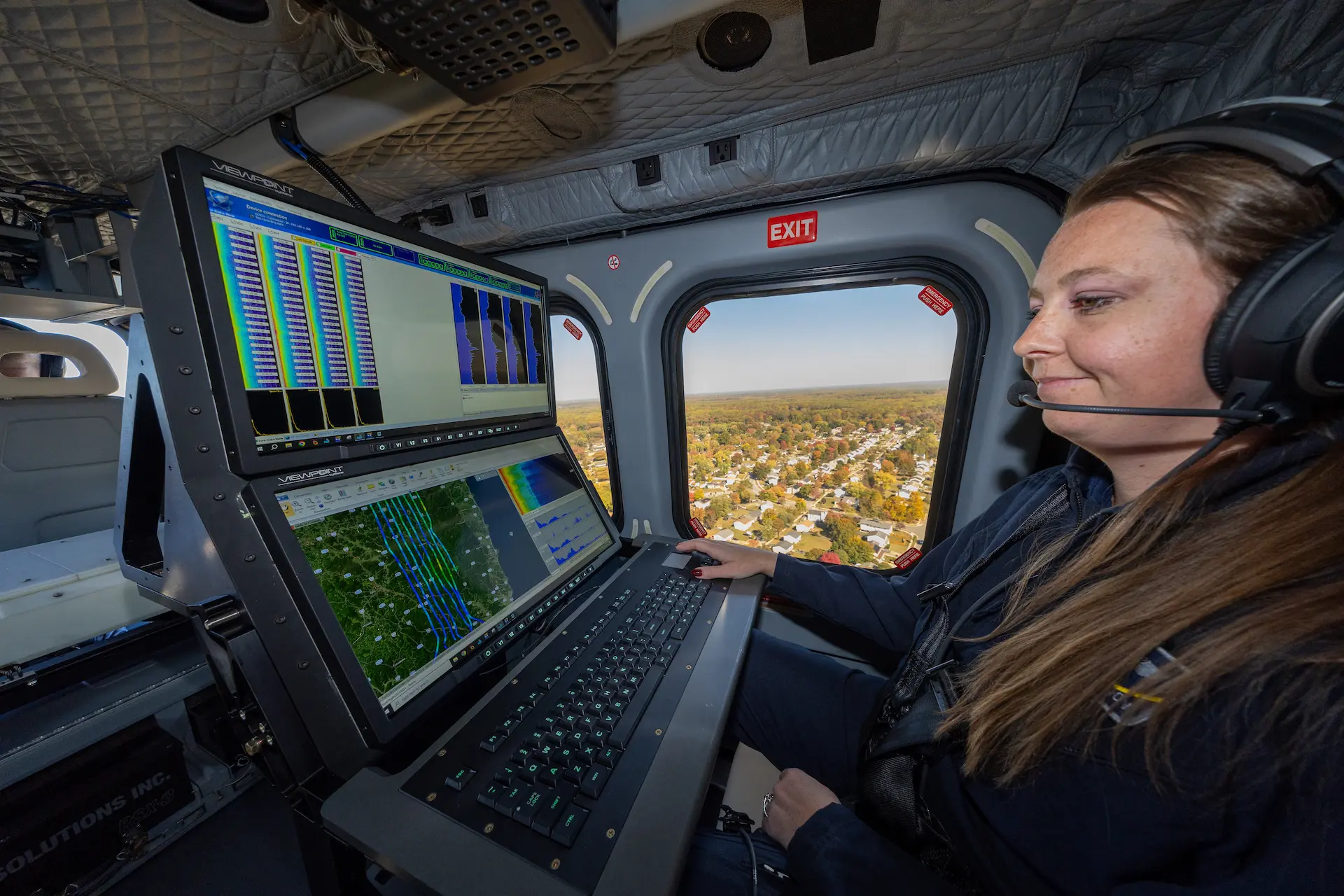
A few years later, after the Boston Marathon Bombing, AMS aircraft have become a regular presence at large public events deemed high-risk by the Department of Homeland Security’s Special Event Assessment Rating (SEAR). Today, the AMS is commonly requested by government and commercial clients for events like marathons, Super Bowls, and New Year’s celebrations. These AMS helicopters conduct detailed baseline radiation surveys before and even during events. This proactive measure not only detects unexpected radiation “hot spots” but also establishes a reference point to aid swift response if a radiological security threat arises.
Additionally, the AMS surveys sensitive sites, such as superfund remediation locations and the sites of current and even potential, nuclear reactors for energy production. The aircraft and crews also train for, and participate in, assisting in radiological asset recoveries, directing specialized units on the ground to the location of expected or unexpected materials of interest.
These low-altitude survey flights have often prompted concerned citizens to call law enforcement or the FAA, unaware of the vital public safety mission carried out by the scientists and aviators onboard the distinctive-looking aircraft. In recent years, the NNSA’s public relations stance has shifted, taking a more proactive approach to raise awareness and educate the public through press releases to the media, before survey flights. However, the AMS crews are still amazed and amused at some of the misconceptions that can be found on social media posts, especially when flying in new locations.
24/7 Coast-to-Coast Response
Focused on public health and safety and rapid response, the AMS team operates as a uniquely specialized unit where pilots, scientists, and leadership seamlessly collaborate to deliver world-leading airborne radiological response capabilities. While AMS is frequently called upon for routine preventative or monitoring surveys, its core mission is emergency nuclear incident response. To maintain their emergency readiness, AMS is structured for continuous, around-the-clock operations, with dedicated crews on standby at each base, ensuring they can deploy within a four-hour window should any incident arise across the continental United States. This dual-base setup not only broadens geographical coverage but also shares the workload, allowing each location to function as a self-sustained unit equipped with skilled pilots, AMS scientists, and support staff to manage both routine surveys and emergency missions within their primary regions of responsibility.
AMS pilots have thousands of hours of experience—many with military backgrounds—and are dual-certified in both fixed-wing and rotary-wing aircraft. This expertise allows them to operate both the King Air and Bell 412 and Leonardo AW139 helicopters, providing flexibility in deploying the right assets for the mission. In a typical emergency response, a King Air is first on the scene to conduct preliminary measurements, followed by a helicopter team to create a detailed map of the incident area.
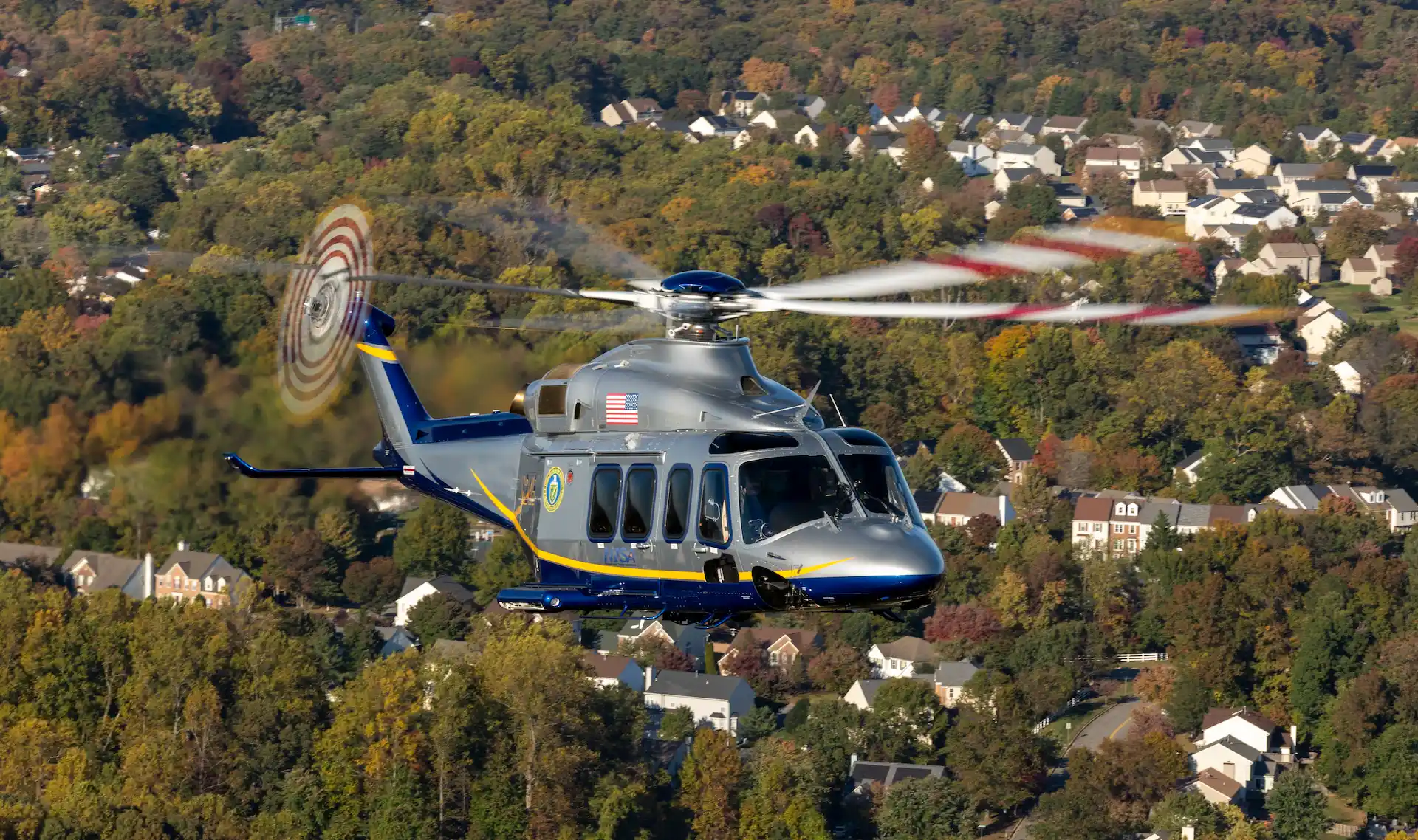
For more than two decades, the NNSA’s AMS relied heavily on its Bell 412 helicopters—a robust and versatile platform that met the demands of radiation surveys for major public events, and emergency deployments. However, as operational needs evolved and technology advanced, the nearly 30-year-old Bell 412s began to show their age and limitations. This shift led NNSA to transition to the Leonardo AW139, a decision that brought a significant upgrade to AMS’s aerial measurement capabilities.
Technical Necessity of the Transition
Valued for its power, twin-engine redundancy, and straightforward, rugged design, the Bell 412 served as the backbone of the AMS helicopter fleet, but the limitations of the aging 412s became increasingly apparent. While capable, its steam-gauge cockpit and manual flight controls demanded constant pilot input, leading to an intense workload during complex missions. Further, the cabin’s tight quarters and lack of air conditioning made long missions a taxing, visceral experience, not only for the pilots, but also for the scientists and technicians operating specialized equipment and at workstations in cramped, sometimes sweltering conditions.
“As reliable as it’s been, the Bell 412 was reaching its limits,” explained Rourke. “There’s only so much we could upgrade before hitting a ceiling. For radiological surveys or emergency response in urban landscapes, we needed something that was more capable and better suited for our missions.”
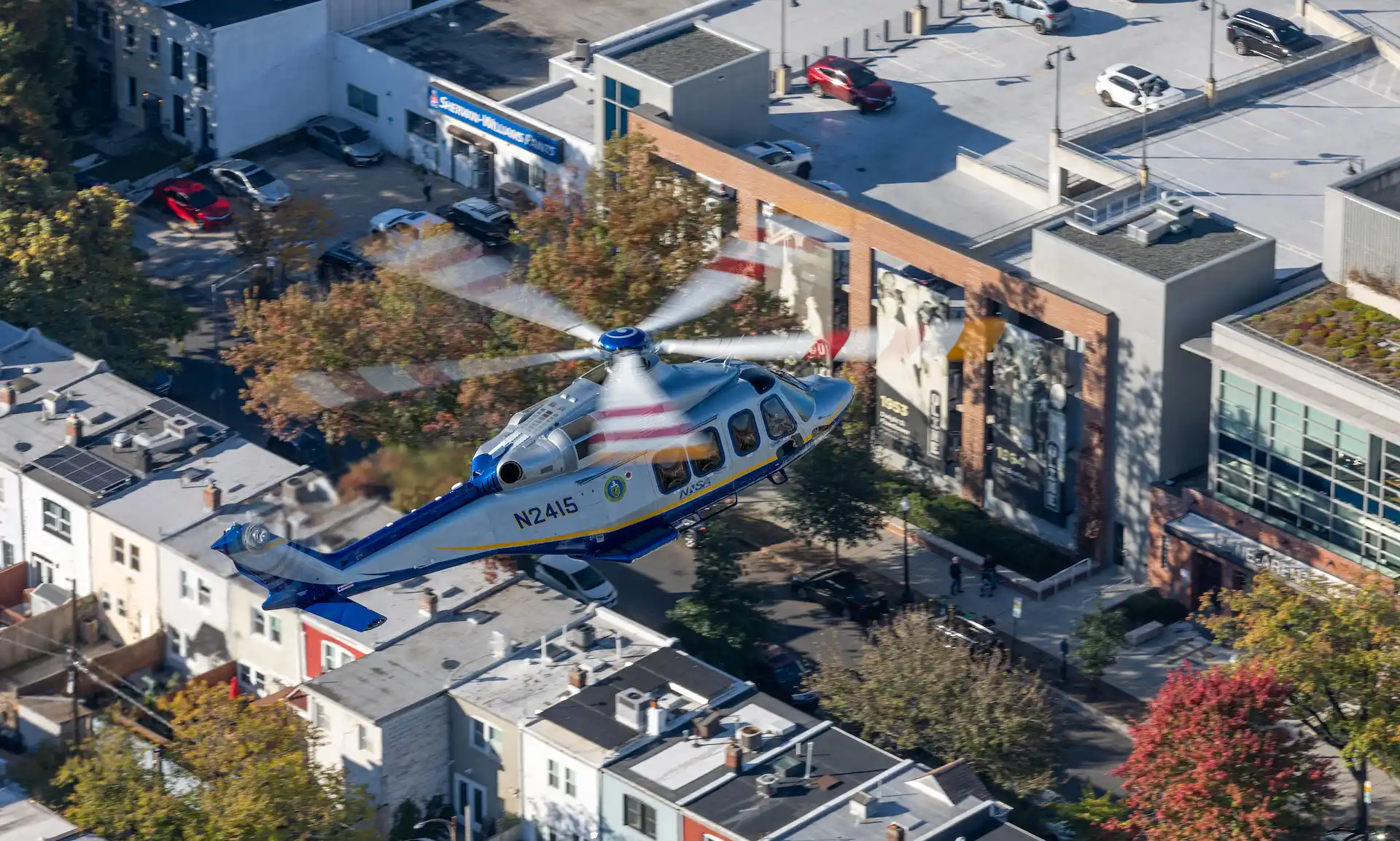
Beyond safety and reliability, the transition was further driven by a desire for greater stability, enhanced payload capacity for advanced detection systems, and improved precision—all without further burdening the crew. These factors led the team to assess several aircraft, ultimately finding the AW139 to provide the greatest value to the government, while also fitting the program’s current and future mission requirements.
The AW139’s Technical Edge and Enhanced Safety
The AW139, a twin-engine, medium-sized helicopter, is engineered for versatility and reliability. Powered by dual Pratt & Whitney PT6C-67C engines, each providing 1,679 shaft horsepower, the AW139 offers an impressive combination of speed, power, and efficiency. The engines are equipped with Full Authority Digital Engine Control (FADEC), which continuously adjusts engine parameters based on flight conditions and pilot inputs, optimizing performance in real-time.
“The aircraft itself, especially the new avionics suite, is a major leap forward.” Remarked, Mission Pilot, Dave Prasek. “It’s like comparing a high-end Cadillac, to a basic Volkswagen.” The AW139 features a fully digital glass cockpit, integrating four large multifunction displays that provide real-time data on flight parameters, navigation, and aircraft systems. Linked to dual integrated flight management systems (FMS), these displays enable pilots to access all critical information at a glance. Additionally, the AW139’s four-axis autopilot offers precise control in all flight conditions, providing stability during long missions and improving safety during low-visibility operations.
The typical flight profile requires the helicopter to fly straight lines at an altitude of about 150 feet and the parallel lines are spaced about 100 to 300 feet apart. “Flying survey lines in the 412 felt like flying the final segment of an ILS approach for two hours straight.” Explained, Mission Pilot, Steve Strawbridge. Both pilots are always highly involved and engaged in ensuring the mission is progressing safely.
“For us, the glass cockpit has been a game-changer,” said NNSA’s Chief Pilot, Alex Brid. “The flight management system greatly reduces our workload, and we’re also finding that the AW139’s autopilot is very reliable, and dependable where we need it.”

The most difficult part about continuously flying in this low-level environment, according to Rourke is always being on the lookout for obstacles. Communication between the pilots and scientist crewmembers in the back is integral to mission success and safety, as is every edge to enhance situational awareness and reduce crew workload that the aircraft and avionics can provide.
Integration of Advanced Detection Systems
The NNSA’s core counterterrorism and counterproliferation mission is to monitor and respond to radiological threats with accuracy and efficiency. This means the ability to detect and measure radiation levels with a high degree of precision is paramount. The AW139 was selected not only for its flight capabilities but also for its compatibility with advanced radiological detection systems.
The Bell 412’s radiation detector configuration was effective, but for missions like these, the more information the sensors can detect, the better. A more sensitive, thus heavier, detection setup was desired. The AW139 carries a larger number of detectors, increasing instrument sensitivity by 50%. This additional sensitivity is crucial for detecting faint radiological signatures in large survey areas or complex urban environments. For instance, the onboard sensors can easily detect the precise levels of ground-level environmentally ambient radiation. This level of predominately naturally occurring radiation is hundreds of times below what is considered a concern to health, yet is easily detected even while flying 150 feet above the ground,
Dr. Jacqueline Brandon, AMS Supervisor of the scientists and technicians in the RSL Joint Base Andrews office, elaborated on this capability: “The increased sensitivity and resolution in our detector arrays mean we can get a much clearer picture of radiological patterns. It’s not just about finding radiation; it’s about understanding its context and accurately identifying its source.”
The AW139’s radiological detection equipment is integrated with a real-time data analysis suite, allowing mission managers to visualize radiation levels in real time on digital maps during the flight. This immediate feedback loop enables rapid decision-making and more precise survey planning. Dr. Brandon added, “The AW139’s enhanced sensitivity and increased capability give us a much broader and clearer picture than we had with our previous aircraft.”
Putting the Pieces Together
Another key advantage of the AW139 is its increased payload capacity and modular design, which allow the NNSA to adapt the helicopter’s equipment setup based on mission requirements. Leonardo’s AW139 can accommodate up to 1,800 pounds more payload than the agency’s Bell predecessor, and the spacious cabin can accommodate multiple sensor arrays along with their vibration-dampening systems, specialized communications hardware, and mission workstations.
While the aircraft were being built, Dr. Brandon coordinated with Leonardo’s engineers to ensure that the new AW139s suited all their needs and allowed the scientists to equip and operate their hundreds of thousands of dollars’ worth of precision detection equipment. “Nearly everything we use is commercially available.” Stated Dr. Brandon, “Figuring out where to place the sensors and workstations, for space and center of gravity concerns, as well as wiring everything for connectivity and power did require some extra attention.”
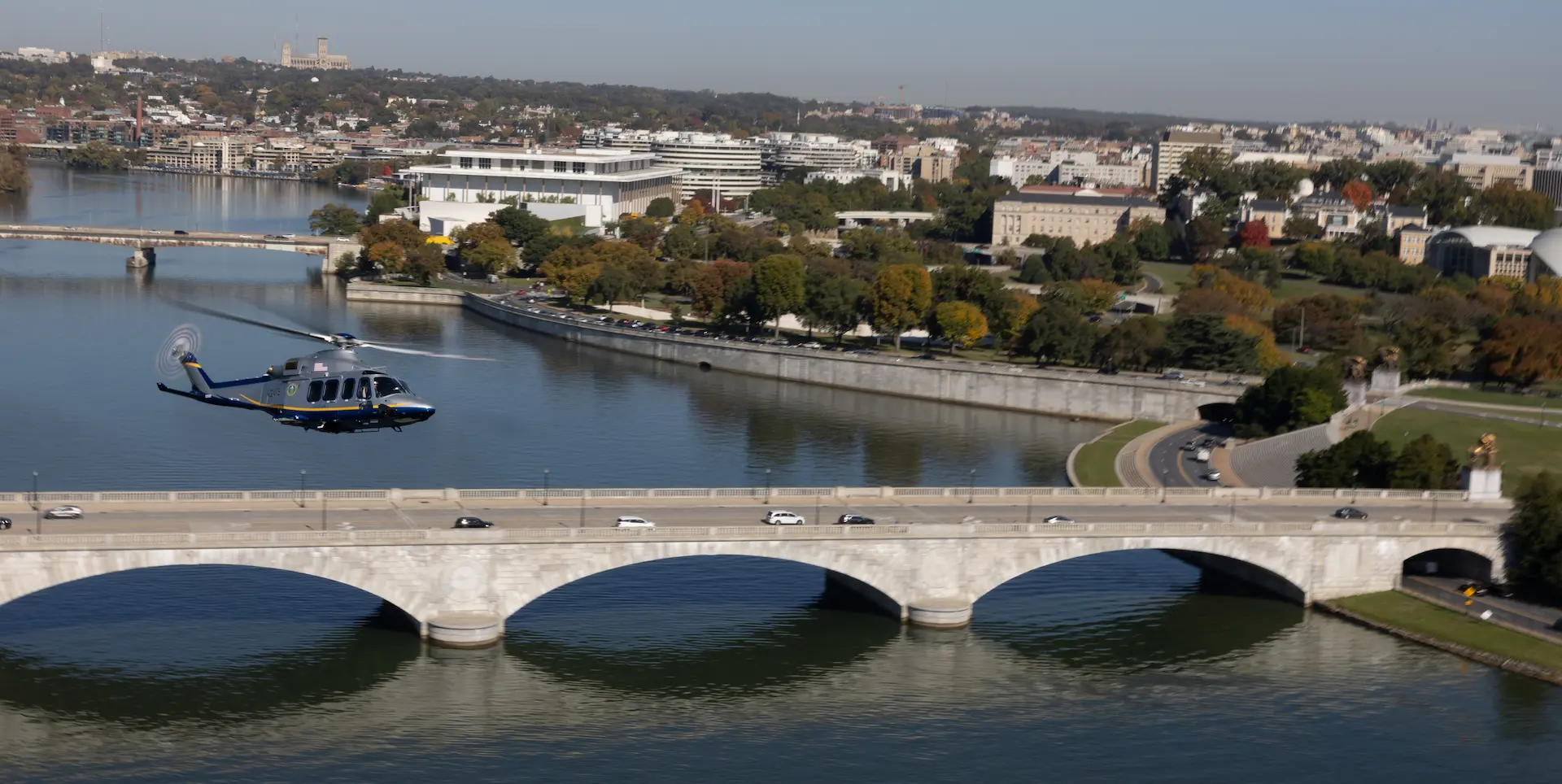
Given the increased cabin space in the AW139, AMS and Leonardo were able install all the sensor equipment from the 412 into the new aircraft. Even the large sensors that were iconically attached to the sides of the 412s were able to be installed inside the 139’s spacious cabin. Interestingly, the primary reason for their external placement was due to fuel tanks being beneath the floor of the 412 which had a variable impact on the sensitivity of the equipment. Despite modularly installing hundreds of pounds of sensors and workstations into the cabin, there is still room to comfortably accommodate the crew of two pilots, one to two mission scientists, and an equipment technician.
Additionally, the aircraft is fitted with enhanced cellular and satellite data transmission capabilities to allow the high bandwidth of
real-time voice communications with national and local government emergency services and data to be streamed to the cloud for detailed
analysis on the ground by the scientists at the DOE national laboratories from anywhere in the world, to rapidly be presented to Incident
Commanders to give them the latest and most precise radiological data and interpretations available.
Operational Performance and Real-World Benefits
The AW139’s performance characteristics offer clear advantages over the Bell 412. With a cruise speed of 150 knots and an operational range of 400 miles, the AW139 has more than an hour and a half longer endurance and flies further than the 412s. This allows them to reach survey areas faster and cover larger areas in each flight, reducing the need for refueling stops and increasing overall mission efficiency. This enhanced speed and range are crucial when missions involve urgent radiological responses or expansive areas to survey.
The AW139’s five-blade main rotor system delivers smoother flight characteristics and reduced vibration levels, directly translating to increased crew comfort and less wear on the aircraft. This improvement in comfort isn’t just about making the ride smoother—it’s about reducing crew fatigue over extended missions. Also contributing greatly to comfort and the reduction of crew fatigue, is the universally welcomed addition of air conditioning in their new aircraft.
“Pilot and crew fatigue was a significant concern with the Bell 412,” Remarked Mission Pilot Bryan Fox. “Particularly on missions that require long periods of low-level flight to complete the surveys.” The manual flight controls and limited automation meant that pilots had to remain fully engaged for the entire duration of the flight. The AW139 addresses this issue with its advanced autopilot system and automated flight controls, allowing pilots to focus on mission-critical tasks such as the exacting task of flying precise survey lines, rather than constantly hand-flying the aircraft from take-off to landing.
“The AW139’s autopilot can handle most of the routine flying tasks,” Brid explained. “It’s not just about convenience—it’s about keeping us fresh and alert during missions that can last for hours.”
Additionally, the AW139’s reduced noise profile is a key advantage. The helicopter’s advanced rotor design and noise-dampening technologies lower its acoustic footprint, making it less intrusive during missions in populated areas or near sensitive sites. This reduction in noise not only helps maintain a lower profile but also minimizes disruptions to the communities in which the team is operating above.
“It’s a win-win,” Rourke added. “We can get in, do our job, and get out without causing a stir. That’s critical when you’re flying over sensitive sites or public events.”
Training and Maintenance Overhaul
Transitioning to the AW139 required a comprehensive overhaul of training programs and maintenance protocols. Pilots underwent extensive retraining, which included classroom sessions, simulator hours, and in-flight mentorship with experienced AW139 instructors. The training focused on mastering the helicopter’s digital avionics, advanced flight controls, and automated systems.
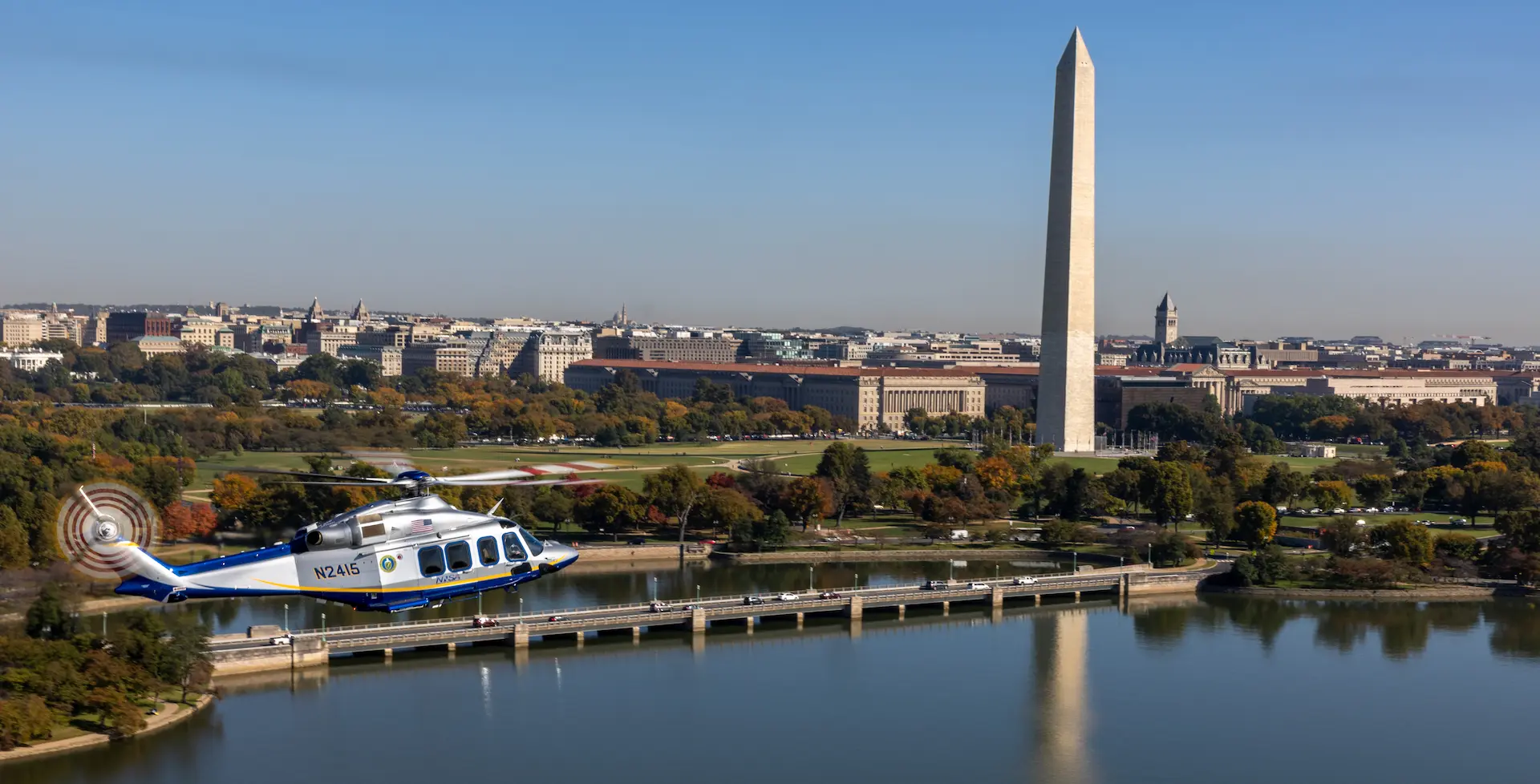
“We didn’t want our pilots to just switch aircraft; we wanted them to be masters of the AW139,” Brid explained. “That’s why we implemented a phased training program that combined simulator hours with real-world flights. It’s not just about getting comfortable—it’s about being competent in every situation we might face.”
Taking a thorough approach to AW139 training, AMS created an internal program that paired pilots with an experienced instructor for 12 real-flight hours before full certification. Each pilot retained their previous status from the 412—whether co-pilot or instructor—only after proving their readiness in live flights, not just in the simulators. “While this gradual, hands-on approach slowed us down initially,” explains Brid, “it’s set a strong foundation, ensuring every pilot is fully prepared to handle low-level, complex missions safely and effectively.”
For maintenance crews, the transition involved significant changes as well. The AW139’s more advanced systems required a deeper understanding of digital diagnostics and predictive maintenance protocols. Complimenting this, the helicopter’s advanced health and usage monitoring system (HUMS) continuously analyzes flight data and identifies potential issues before they escalate, allowing for more proactive maintenance scheduling.
Future Capabilities
The AMS team is already exploring additional upgrades to the AW139’s capabilities, including the integration of heads-up displays (HUDs) for improved situational awareness, and enhanced flight features to further reduce pilot workload during routine operations.
The advanced capabilities of the aircraft and avionics also allow for easier expansion of the aircraft’s mission equipment in the future should the NNSA choose to add additional imaging systems or electro-optical sensors to the aircraft. This would provide AMS with the ability to collect visible light, (Forward Looking InfraRed) FLIR or thermal video and still images of areas of interest during their operations and surveys. These future enhancements align with the agency’s commitment to continuous improvement and readiness for emerging threats.
“This upgrade isn’t just about us,” Dr. Brandon emphasized. “It’s about setting a new standard in radiological safety and being ready to support critical missions when called upon.”
The transition from the Bell 412 to the AW139 represents a strategic leap forward for NEST’s Aviation Team. It’s not just about upgrading to a newer helicopter—it’s about enhancing every aspect of their mission capabilities, from safety and stability to detection sensitivity and operational efficiency. The new helicopters bring a modernized, data-driven approach to radiological safety, allowing the team to respond more effectively and efficiently to emergencies and protect public health with greater precision and confidence.
With the AW139s now fully integrated into the fleet, NEST’s AMS is better equipped than ever to navigate the complexities of radiological monitoring and nuclear emergency response, wherever and whenever the call comes. The team’s forward-looking approach and commitment to innovation ensure that they will continue to set the standard for radiological public health and safety and emergency preparedness for years to come.
 HOME
HOME


